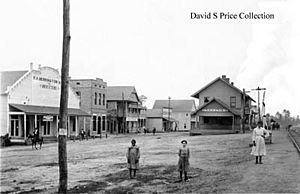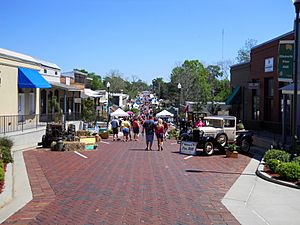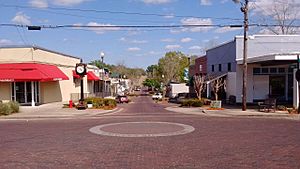Wiggins, Stone County, Mississippi facts for kids
Quick facts for kids
Wiggins, Mississippi
|
|
|---|---|
| City of Wiggins | |
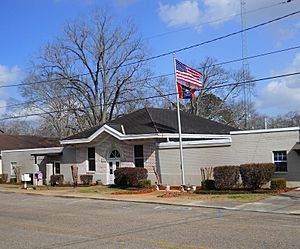
Wiggins City Hall in January 2021
|
|
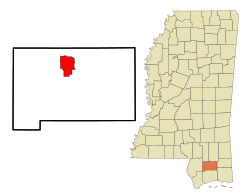
Location of Wiggins, Mississippi
|
|
| Country | United States |
| State | Mississippi |
| County | Stone |
| Area | |
| • Total | 11.26 sq mi (29.17 km2) |
| • Land | 10.75 sq mi (27.84 km2) |
| • Water | 0.51 sq mi (1.33 km2) |
| Elevation | 262 ft (80 m) |
| Population
(2020)
|
|
| • Total | 4,272 |
| • Density | 397.40/sq mi (153.44/km2) |
| Time zone | UTC-6 (Central (CST)) |
| • Summer (DST) | UTC-5 (CDT) |
| ZIP code |
39577
|
| Area code(s) | 601, 769 |
| FIPS code | 28-80160 |
| GNIS feature ID | 2405742 |
Wiggins is a city located in Stone County, Mississippi, United States. It is the main city and the county seat of Stone County. Wiggins is also part of the larger Gulfport–Biloxi Metropolitan Statistical Area. In 2020, about 4,272 people lived in Wiggins.
Contents
History of Wiggins
Wiggins got its name from Wiggins Hatten. He was the father of Madison Hatten, one of the first people to settle in this area. The city officially became a town in 1904. By 1910, it had 980 residents.
Timber Industry and Growth
In the early 1900s, Wiggins grew quickly because of the booming timber industry. The Finkbine Lumber Company once had its main office here. This shows how important timber was to the city's early success.
The Great Fire of 1910
On January 21, 1910, a big fire destroyed more than half of Wiggins' business area. The fire started in a lodging house called the Hammock Building. Strong winds helped the fire spread very fast.
Wiggins did not have a fire department or a water system back then. People tried to stop the fire by forming bucket brigades and even using dynamite. The fire stayed on the east side of the Gulf and Ship Island Railroad tracks. It burned down 41 businesses, including the railroad depot. Luckily, most homes were built away from the business district, so only a few houses were destroyed.
Pickle Production and Modern Changes
Wiggins was once famous for making pickles. It even had what was called the world's largest pickle processing factory. This factory is now closed. While the timber industry is not as big as it used to be, it still supports many businesses in Wiggins today.
In June 2021, Wiggins made history by electing its first African-American mayor, Darrell Berry. He had served as a city council member for 12 years before becoming mayor. At that time, three African-American members were serving on the city council together.
Pine Hill Area
After the 1910 fire, the main shopping area of Wiggins grew along Pine Avenue. This street sloped downhill and had many small shops. These shops were home to different businesses over the years. They included drug stores, law offices, grocery stores, and even a movie theater.
In the late 1960s, U.S. Route 49 was built to go around the downtown area. This caused many businesses to move from Pine Hill to other parts of Wiggins. The old school buildings at the bottom of Pine Hill were torn down in the 1970s. This land became Blaylock Park, a city park.
Pine Hill Festival
In the 1980s, local leaders wanted to create a stronger sense of community. They started an annual event called Pine Hill Day, which later became the Pine Hill Festival. During this festival, people sell arts and crafts, fresh produce, and local food. Over the years, the festival added live music, races, antique car displays, and games for kids. It is now a popular Spring event. In 2014, about 15,000 people attended the two-day festival.
Geography of Wiggins
Wiggins covers a total area of about 11.3 square miles (29.17 square kilometers). Most of this area is land, about 10.8 square miles (27.84 square kilometers). The rest, about 0.5 square miles (1.33 square kilometers), is water. The entrance to Flint Creek Water Park is located within the city, near Highway 29.
Population and People
| Historical population | |||
|---|---|---|---|
| Census | Pop. | %± | |
| 1910 | 980 | — | |
| 1920 | 1,037 | 5.8% | |
| 1930 | 1,074 | 3.6% | |
| 1940 | 1,141 | 6.2% | |
| 1950 | 1,436 | 25.9% | |
| 1960 | 1,591 | 10.8% | |
| 1970 | 2,995 | 88.2% | |
| 1980 | 3,205 | 7.0% | |
| 1990 | 3,185 | −0.6% | |
| 2000 | 3,849 | 20.8% | |
| 2010 | 4,390 | 14.1% | |
| 2020 | 4,272 | −2.7% | |
| U.S. Decennial Census 2012 Estimate |
|||
As of the 2020 United States census, Wiggins had 4,272 people living in the city. There were 1,348 households and 889 families.
| Race | Number | Percent |
|---|---|---|
| White | 2,661 | 62.29% |
| Black or African American | 1,348 | 31.55% |
| Native American | 15 | 0.35% |
| Asian | 26 | 0.61% |
| Pacific Islander | 1 | 0.02% |
| Other/Mixed | 145 | 3.39% |
| Hispanic or Latino | 76 | 1.78% |
Education in Wiggins
- The Stone County School District serves the city of Wiggins.
- Gateway Christian Academy is a private school that teaches students from preschool up to 12th grade.
Local Media
- The Stone County Enterprise is the local newspaper, which has been published since 1916.
- Wiggins is also part of the Mississippi Gulf Coast area for radio and television stations.
Transportation
- Airport: Dean Griffin Memorial Airport
- Highways: U.S. Highway 49, Mississippi Highway 26, Mississippi Highway 29
- Railroad: Kansas City Southern Railroad
Famous People from Wiggins
Many notable people have connections to Wiggins, including:
- William Joel Blass, a lawyer and educator.
- Sammy Brown, a professional football player.
- Jay Hanna "Dizzy" Dean, a famous professional baseball player and radio personality. He lived nearby in the Bond community.
- Justin Evans, a professional football player.
- Anthony Herrera, an actor known for soap operas.
- Boyce Holleman, a lawyer and actor.
- Fred Lewis, a former outfielder for the Cincinnati Reds baseball team.
- Stevon Moore, a retired NFL player for the Cleveland Browns and Baltimore Ravens.
- Taylor Spreitler, an actress.
Images for kids
See also
 In Spanish: Wiggins (Misisipi) para niños
In Spanish: Wiggins (Misisipi) para niños



